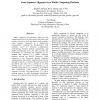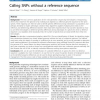36 search results - page 4 / 8 » Optimal spliced alignments of short sequence reads |
ICPPW
2005
IEEE
14 years 3 months ago
2005
IEEE
Public computing can potentially supply not only computational power but also memory and short term storage resources to grid and cluster scale problems. Gene sequence alignment i...
CIBCB
2007
IEEE
14 years 4 months ago
2007
IEEE
—DNA matching is a crucial step in sequence alignment. Since sequence alignment is an approximate matching process there is a need for good approximate algorithms. The process of...
BMCBI
2007
13 years 9 months ago
2007
Background: Sequence comparison faces new challenges today, with many complete genomes and large libraries of transcripts known. Gene annotation pipelines match these sequences in...
BMCBI
2010
13 years 10 months ago
2010
Background: The most common application for the next-generation sequencing technologies is resequencing, where short reads from the genome of an individual are aligned to a refere...
BMCBI
2011
13 years 4 months ago
2011
Background: Genomic position (GP) files currently used in next-generation sequencing (NGS) studies are always difficult to manipulate due to their huge size and the lack of approp...


